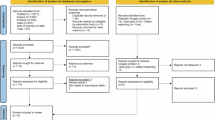Abstract
Data sources The electronic databases MEDLINE, EMBASE, Google Scholar, the Cochrane Oral Health Group's Trials Register, and CENTRAL from 1946 to 31 March 2018 were searched to identify eligible studies. Information sources in the Grey literature were also searched.
Study selection Randomised and non-randomised studies as well as retrospective studies irrespective of their language were selected by two reviewers independently.
Data extraction and synthesis Data extraction and risk of bias assessments were performed by two reviewers independently. Data were synthesised qualitatively. Quantitative syntheses were not possible because of high heterogeneity.
Results One randomised controlled trial, four cross-sectional studies, and three retrospective studies were selected according to the eligibility criteria. The quality of the evidence in the included studies was predominantly of low to moderate quality. All studies reported on Twitter, three on YouTube, two on Facebook and one study referred also to Google+, Pinterest, Instagram, and Internet Blogs. The included studies reported on the informational value of social media on various aspects of orthodontic treatment and patients' health experiences during orthodontic treatment.
Conclusions The authors of this review concluded that social media represent a basic resource for exchanging knowledge on a wide variety of aspects of orthodontics.
Similar content being viewed by others
Log in or create a free account to read this content
Gain free access to this article, as well as selected content from this journal and more on nature.com
or
References
Papadimitriou A, Kakali L, Pazera P, Doulis I, Kloukos D. Social media and orthodontic treatment from the patients perspective: a systematic review. Eur J Orthod 2019: DOI: 10.1093/ejo/cjz029. [Epub ahead of print] PubMed PMID: 31107943.
Liberati A, Altman D G, Tetzlaff J et al. The PRISMA statement for reporting systematic reviews and meta-analyses of studies that evaluate health care interventions: explanation and elaboration. PLoS Med 2009; 6: e1000100.
Moher D, Liberati A, Tetzlaff J, Altman DG; PRISMA Group. Preferred reporting items for systematic reviews and meta-analyses: the PRISMA statement. PLoS Med 2009; 6: e1000097.
Shea B J, Reeves B C, Wells G et al. AMSTAR 2: a critical appraisal tool for systematic reviews that include randomised or non randomised studies of healthcare interventions, or both. BMJ 2017; 358: j4008. DOI: 10.1136/bmj.j4008.
Risk of bias in systematic reviews (ROBIS). ROBIS tool and the ROBIS guidance document. Available at http://www.bristol.ac.uk/population-health-sciences/projects/robis/ (accessed September 23th 2019).
Whiting P, Savović J, Higgins J P et al. ROBIS group. ROBIS: A new tool to assess risk of bias in systematic reviews was developed. J Clin Epidemiol 2016; 69: 225-234.
Stewart L, Moher D, Shekelle P. Why prospective registration of systematic reviews makes sense. Syst Rev 2012; 1: 7.
Higgins J P T, Deeks J J. Chapter 7: Selecting studies and collecting data. In Higgins J P T, Green S (editors), Cochrane Handbook for Systematic Reviews of Interventions Version 5.1.0 (updated March 2011). The Cochrane Collaboration, 2011. Available at www.cochrane-handbook.org (accessed September 2019).
Higgins J P T, Altman D G, Sterne J A C. Chapter 8: Assessing risk of bias in included studies. In Higgins J P T, Green S (editors) Cochrane Handbook for Systematic Reviews of Interventions Version 5.1.0 (updated March 2011). The Cochrane Collaboration, 2011. Available at www.cochrane-handbook.org (accessed September 2019).
A revised tool to assess risk of bias in randomized trials (RoB 2). Available from: https://www.riskofbias.info/welcome/rob-2-0-tool (accessed September 25th 2019).
Sterne J A C, Savović J, Page M J et al. RoB 2: a revised tool for assessing risk of bias in randomised trials. BMJ: In press.
Bondemark L, Holm A K, Hansen K et al. Long-term stability of orthodontic treatment and patient satisfaction. A systematic review. Angle Orthod 2007; 77: 181-191.
Hartling L, Hamm M, Milne A, Vandermeer B et al. Validity and inter-rater reliability testing of quality assessment instruments. (Prepared by the University of Alberta Evidence-based Practice Centre under Contract No. 290200710021I.) AHRQ Publication No. 12EHC039EF. Rockville, MD: Agency for Healthcare Research and Quality. March 2012. Available at www.effectivehealthcare.ahrq.gov/reports/final.cfm (accessed September 2019).
Hartling L, Milne A, Hamm M P et al. Testing the Newcastle Ottawa Scale showed low reliability between individual reviewers. J Clin Epidemiol 2013; 66: 982-993.
Lo C K, Mertz D, Loeb M. Newcastle-Ottawa Scale: comparing reviewers' to authors' assessments. BMC Med Res Methodol 2014; 14: 45.
Stevens A, Garritty C, Hersi M, Moher D. Developing PRISMA-RR, a reporting guideline for rapid reviews of primary studies (Protocol). Available at http://www.equator-network.org/wp-content/uploads/2018/02/PRISMARRprotocol.pdf (accessed August 16th 2019).
Al-Silwadi F M, Gill D S, Petrie A, Cunningham S J. Effect of social media in improving knowledge among patients having fixed appliance orthodontic treatment: A single-centre randomized controlled trial. Am J Orthod Dentofacial Orthop 2015; 148: 231-237.
Author information
Authors and Affiliations
Corresponding author
Rights and permissions
About this article
Cite this article
Reynders, R., Isaia, L. Social media and orthodontics: A commentary on a systematic review. Evid Based Dent 20, 123–126 (2019). https://doi.org/10.1038/s41432-019-0060-3
Published:
Issue date:
DOI: https://doi.org/10.1038/s41432-019-0060-3
This article is cited by
-
Evaluation of the quality of information on the internet about 2019 coronavirus outbreak in relation to orthodontics
Health and Technology (2021)



